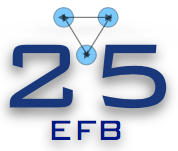Speaker
Description
Studies of few-nucleon systems form the basis for understanding nuclear interactions and properties of nuclei. The very accurate theoretical calculations for three nucleon systems should be confronted with a rich set of presice experimental data.
For this purpose, the BINA (Big Instrument for Nuclear-polarization Analysis) detection system has been installed at CCB (Cyclotron Center Bronowice) [1]. The BINA setup is designed to study the elastic and breakup reactions at intermediate energies. It consists of the liquid target facility and the low threshold detector covering nearly 4$\pi$ solid angle, enabling studies of almost full phase space of these reactions [2, 3].
The data analysis and results of the first experimental run of proton-induced deuteron breakup at a beam energy of 108 MeV will be presented. The data are normalized to the known cross section for proton-deuteron elastic scattering [4]. Differential cross section determined for a set of over 100 kinematic configurations of outgoing protons in the range of polar angles from 13 to 27 degrees and azimuthal angles from 10 to 190 degrees will be compared to state of the art theoretical calculations to study the role of the Three Nucleon Force, Coulomb, and relativistic effects.
Moreover, the research was extended by introducing a new detector, which enabled the determination of pn pairs from the breakup reaction and their direct comparison with the previously determined pp pairs for selected FSI configurations.
[1] A. Łobejko et al., Acta Phys.Pol.B. bf 50, 3, p. 361-366 (2019).
[2] St. Kistryn, E. Stephan, J.Phys.G: Nucl.Part.Phys. 40, 063101 (2013).
[3] A. Ramazani-Moghaddam-Arani, et al., Phys.Rev.C 78, 014006} (2008).
[4] K. Ermisch, et al., Phys.Rev.C 68, 051001 (2005).

